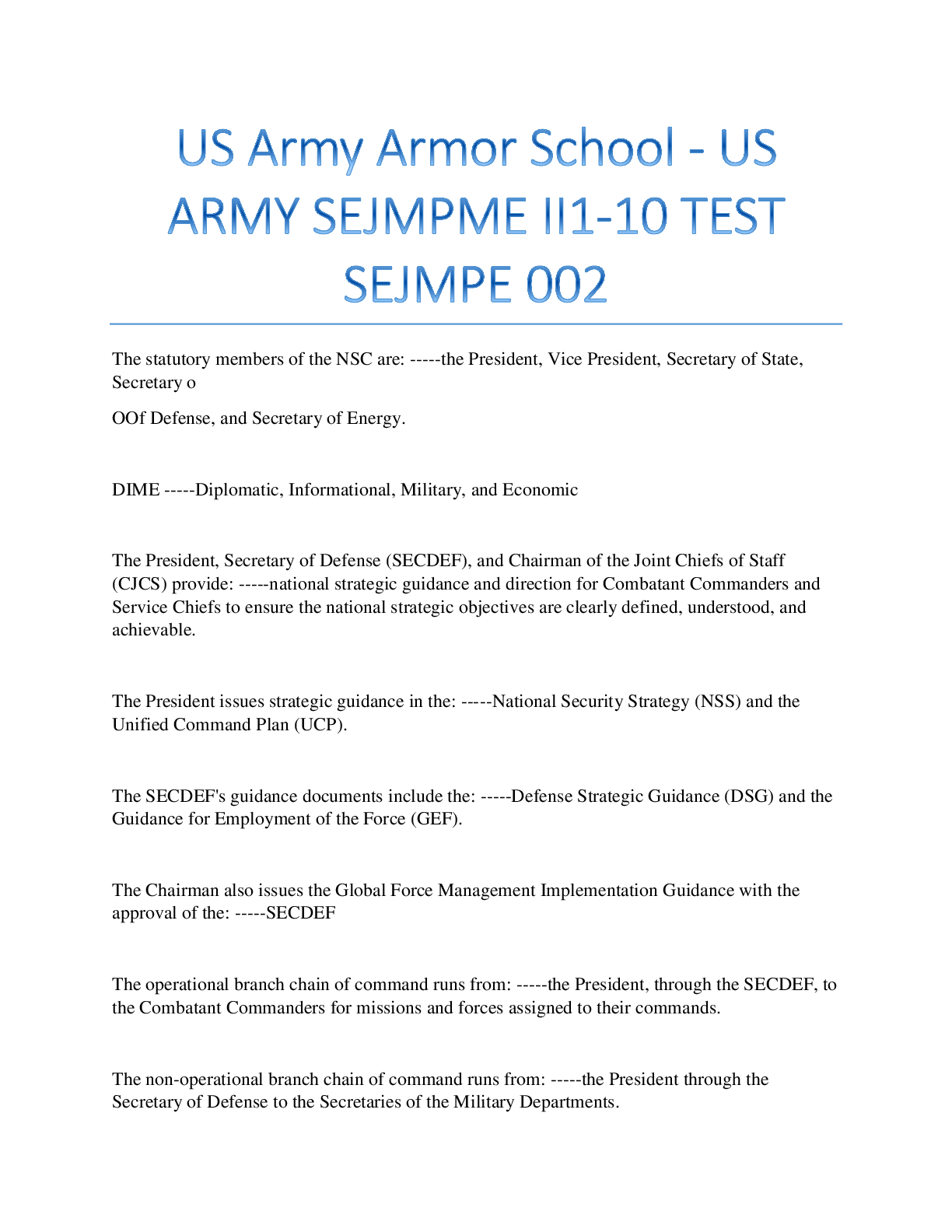*NURSING > QUESTIONS & ANSWERS > Gero Exam 1 - chap 1, 2, 3, 4, 5, 6. Questions and answers, 2022 update, Graded A+ (All)
Gero Exam 1 - chap 1, 2, 3, 4, 5, 6. Questions and answers, 2022 update, Graded A+
Document Content and Description Below
Gero Exam 1 - chap 1, 2, 3, 4, 5, 6. Questions and answers, 2022 update, Graded A+ 1. In 2010, the revised Standards and Scope of Gerontological Nursing Practice was published. The nurse would us... e these standards to: - ✔✔ANS: D The current publishing of the Standards and Scope of Gerontological Nursing Practice in 2010 incorporates the input of gerontologic nurses from across the United States. It was not intended to promote gerontologic nursing practice within acute care settings, define concepts or dimensions of gerontologic nursing practice, or elevate the practice of gerontologic nursing. 2. When attempting to minimize the effect of ageism on the practice of nursing older adults, a nurse needs to first: - ✔✔ANS: C Ageism is an ever-increasing prejudicial view of the effects of the aging process and of the older population as a whole. With nurses being members of a society holding such views, it is critical that the individual nurse self-reflect on personal feelings and determine whether such feelings will affect the nursing care that he or she provides to the aging patient. Acting as an advocate is an important nursing role in all settings. Simply accepting a fact does not help end ageism, nor does recognizing ageism as a form of bigotry. 3. When discussing factors that have helped to increase the number of healthy, independent older Americans, the nurse includes the importance of: - ✔✔ANS: C The health and ultimate autonomy of older Americans has been positively impacted by the development of antibiotics, better sanitation, and vaccines. These public health measures have been more instrumental in increasing the numbers of healthy, independent older Americans than have in-home care services, government programs, or life-extending therapies. 4. Based on current data, when presenting an older adult's discharge teaching plan, the nurse includes the patient's: - ✔✔ANS: C Less than 4% of older adults live in a formal health care environment. The majority of the geriatric population lives at home or with family members. 5. The nurse planning care for an older adult who has recently been diagnosed with rheumatoid arthritis views the priority criterion for continued independence to be the patient's:. - ✔✔ANS: D Maintaining the functional status of older adults may avert the onset of physical frailty and cognitive impairment, two conditions that increase the likelihood of institutionalization. 6. A nurse working with the older adult population is most likely to assess a need for a financial social service's referral for a(n): - ✔✔ANS: B The poverty rate among older black women is substantially higher than that seen among males or females of other ethnic groups. White males had the least poverty 7. Which of the following statements made by a nurse preparing to complete a health assessment and history on an older patient reflects an understanding of the general health status of this population? - ✔✔ANS: D It is a misconception that old age is synonymous with disease and illness. The nurse should always determine the patient's sense of wellness and independence when conducting a health and history assessment. An assessment of medication use and family support is important for any patient. Many older adults do have chronic health conditions, but their perception is more important than a single number. 8. The nurse is caring for an older adult who has been admitted to an acute care hospital for treatment of a fractured femur. The family expresses concern about the patient's pending transfer to a subacute care facility. What response by the nurse is best? - ✔✔ANS: C The transfer of the patient to a subacute facility is based on the need to maintain the patient's level of function and independence, a task the acute care facility is not prepared to address once the patient is physiologically stable. The patient may or may not be happier in the new setting; the nurse should not make this judgment. It is true that insurance only pays for a limited amount of time in an acute care facility, but this is not the best reason for the patient to transfer 9. To best assure both the quality of care and the safety of the older adult patient who requires in-home unlicensed assistive personal (UAP) assistance, the geriatric nurse: - ✔✔ANS: A As more care traditionally provided by professional nurses is being transferred to UAP, the nurse must assume more responsibility for educating, training, and evaluating the competency of UAP staff to provide safe, effective care for the older adult patient. 10. The nurse working with older adults understands what information about certification in gerontologic nursing? - ✔✔ANS: B Certification is voluntary and shows that a nurse has additional knowledge and expertise in a certain area of practice. It is not mandatory in specific care settings. It does not allow for third-party reimbursement. It may be part of a career ladder program, but that is not true of all work settings. 11. A nurse works in a gerontologic clinic. What action by the nurse takes highest priority? - ✔✔ANS: C One of the challenges and priorities of the gerontologic nurse is helping patients maintain their independence. 12. A nurse is caring for an older patient in the emergency department. What information about the patient will be most helpful in creating a plan of care? - ✔✔ANS: A The nurse is encouraged to view older patients as individuals and consider their baseline physical and cognitive functional status as a standard by which to compare the patient's current status. The other information is also important, but the basis of individualized care begins with the patient's strengths and weaknesses. 13. The faculty member explains to students that many older Americans continue to work past the "retirement age." What best explains this trend? - ✔✔ANS: B As financial situations may have declined as a result of many economic factors, more older adults work past their "retirement age." The other options may be reasons for some to continue working, but financial necessity is the reason the majority continue to do so. 14. What information does the faculty member teach students about Medicare? - ✔✔ANS: A Although Medicare is primarily for those over the age of 65, it does cover people of any age with end-stage kidney disease. Part A covers hospital costs. Part B is medical insurance. The "donut hole" was fixed by the Affordable Care Act. 15. A nursing manager notes that many older patients are admitted to the nursing unit for acute problems. What action can the manager take to most benefit this population? - ✔✔ANS: B Many older adults need acute care for sudden illness and injury but live in a state of functional decline, which could possibly be prevented by establishing a restorative therapy program. The other actions will help the older patients cared for in the unit, but only to limited degrees. 16. The dean of a new nursing program wishes to ensure graduates are prepared to care for older patients. What document should guide the dean in designing the curriculum? - ✔✔ANS: D The Recommended Baccalaureate Competencies and Curricular Guidelines for the Nursing Care of Older Adults is an updated version of The Essentials of Baccalaureate Education for Professional Nursing Practice. This document was first published by the American Association of Colleges of Nursing (AACN) in 2008 and was updated in 2010. The other three documents do not have information about curricular requirements to prepare students to care for the older population. 17. A nurse wants to plan a community event at a retirement center. What topic would most likely be best received? - ✔✔ANS: A Older adults are demanding more programs and services aimed at health maintenance and promotion and disease and disability prevention. Based on this information, the heart healthy living presentation would be best received. 18. What does the bedside nurse understand about his or her role in nursing research? - ✔✔ANS: B All nurses are charged to deliver patient-centered care based on evidence-based practice, research, quality improvement, and informatics. The bedside nurse is part of an interdisciplinary team that is responsible for redesigning the health care structure of the future. 1. The clinic nurse caring for an older diabetic patient with a sixth grade education anticipates that the patient may experience difficulty (Select all that apply.) - ✔✔ANS: A, B, C Even though the educational level of the older population has steadily increased, as a population they are less educated than the general population. This deficiency can account for a lack of understanding regarding the need for medical care and the importance of following a treatment plan. These patients may also have fewer financial resources to devote to health care issues. 2. The nurse studying the history of gerontologic nursing learns which information about the specialty? (Select all that apply.) - ✔✔ANS: B, C, E The geriatric nursing conference group was established in 1962, the gerontologic clinical nurse specialist certification was first offered in 1989, and the first Standards of Practice for Geriatric Nursing was written in 1969. The population of older Americans is the fastest-growing subset of the population. Writings about care of the aged can be found from as early as 1900 3. The student asks the gerontologic clinic nurse why so many older people are women. What information does the nurse provide? (Select all that apply.) - ✔✔ANS: A, C, D A decrease in maternal mortality, decreased deaths from infectious diseases, and more chronic illness in men account for the disparity in genders as people age. 4. The gerontologic nurse plans community programming for older women, noting what facts about this population subgroup? (Select all that apply.) - ✔✔ANS: A, B, D Older women have a greater chance than men of living alone and in poverty. They also have a greater degree of functional impairment and chronic disease 5. The nurse knows that the most common causes of death in the older population result from which diseases? (Select all that apply.) - ✔✔ANS: A, C, D The most common causes of death in the older population are cerebrovascular disease, heart conditions, and cancer. End-stage renal disease and diabetes are not among the top three causes of death. 1. The practitioner who believes in the free radical theory of aging is likely to recommend that the older adult: - ✔✔ANS: B Vitamins C and E are two naturally occurring antioxidants that appear to inhibit the functioning of the free radicals or possibly decrease their production in the body. The free radical theory of aging is not related to zinc, magnesium, carbohydrates, or alcohol and tobacco. 2. To provide effective care to the older adult, the nurse must understand that: - ✔✔ANS: A The key societal issue addressed by the age stratification theory is the concept of interdependence between the aging person and society at large. This theory views the aging person as an individual element of society and also as a member, with peers, interacting in a social process. The theory attempts to explain the interdependence between older adults and society and how they constantly influence each other in a variety of ways. Variation exists among the members of a cohort. Health problems are not the same for every individual of the same age. Withdrawal by an older adult is not a normal response to aging but may be a sign of depression. 3. The nurse is using the eight stages of life theory to help an older adult patient assess the developmental stage of personal ego differentiation. The nurse does this by assisting the patient to: - ✔✔ANS: C During the stage of ego differentiation versus work role preoccupation, the task for older adults is to achieve identity and feelings of worth from sources other than the work role. The onset of retirement and termination of the work role may reduce feelings of self-worth. In contrast, a person with a well-differentiated ego, who is defined by many dimensions, can replace the work role as the major defining source for self-esteem. Determining feelings related to the effects of aging, future death, or what the future may hold is not part of this theory. 4. A patient is recovering from a mild cerebral vascular accident (stroke). The home care nurse notes that the patient is talking about updating a will and planning funeral arrangements. Which of the following responses is most appropriate for the nurse to make? - ✔✔ANS: B According to Peck's expansion of Erikson's theory, the older adult who has successfully achieved ego integrity and ego transcendence accepts death with a sense of satisfaction regarding the life led and without dwelling on its inevitability. The patient's action reflects a healthy transition and should be supported 5. Your patient's spouse died recently from a sudden illness after 45 years of marriage. The patient was the primary caregiver for the spouse during this time. The patient is now depressed and withdrawn and has verbalized feelings of uselessness. Which action by the nurse is best? - ✔✔ANS: B Volunteering will help the patient to interact with people and feel productive and valued for the ability to help others as stated in the activity theory. A hobby does not offer the chance to help others. Assuring the patient that feelings will pass is false reassurance and does nothing to help the patient to be proactive. Reminiscing is a valued activity, but it is not the best choice for regaining a sense of usefulness. 6. A patient has recently been diagnosed with end-stage renal disease. The patient has cried often throughout the day and finally confides in the nurse that "I am going home to be with my Lord." The nurse's best response is: - ✔✔ANS: C It is important for the nurse to acknowledge the spiritual dimension of a person and support spiritual expression and growth while addressing spirituality as a component in holistic care without imposing upon the patient. Because the patient has made reference to the Lord, the nurse can safely offer religion-oriented spiritual care. Telling the patient there is no reason to believe that death is near does not help the patient work through emotions. Asking about calling the family is a yes/no question and is not therapeutic. The nurse is assuming too much by saying it is time to pray. 7. A nurse is responsible for the care of 20 older adults in a unit of an assisted living facility. In order to best address the needs and wants of the entire unit's population, the nurse: - ✔✔ANS: D Older adults continue to feel valued and viewed as active members of society when allowed to maintain a sense of control over their living environment by attention to personal choices and rituals. Adhering strictly to policies does not allow for individualized care. Not all in the same age cohort will have similar interests. Voting on television programs does not ensure each individual feels a sense of worth. 8. An older patient who reports being "healthy enough to cut my own fire wood" is being assessed prior to outpatient surgery. The nurse recognizes which assessment observation as a possible result of the wear-and-tear theory? - ✔✔ANS: C This theory proposes that cells wear out over time because of continued use. The pain caused by movement of the shoulder is the observation most likely a result of the patient's practice of cutting his own firewood. The other choices do not demonstrate continued use that is part of the wear-and-tear theory of aging. 9. A nurse cares for many older patients. Which finding should the nurse identify as pathologic in a 72-year-old? - ✔✔ANS: A Although there is an age-related decrease in immune function, reoccurring infections serious enough to require hospitalization are not considered a normal age-related finding. Decreased sleeping, thinning hair, brittle nails, and dry skin are all normal signs of aging. 10. In planning the care for an older adult patient, the nurse will best promote health and wellness by: - ✔✔ANS: C Providing well-prepared and effectively delivered health-related educational information will provide the best means of promoting a patient's ability to impact his or her wellness and general health. Each of the other options is too narrow to be the most effective way to promote health and wellness 11. The student learning about aging theories understands that the main difference between stochastic theories and nonstochastic theories is which of the following? - ✔✔ANS: A Stochastic theories view aging as a result of random events and their cumulative effects. Nonstochastic theories view aging as a result of predetermined, timed phenomena. Both are types of biologic theories. 12. Which theory of aging does the student learn is related to problems with DNA transcription? - ✔✔ANS: B The error theory poses that errors in DNA transcription lead to aging. The radical theory views the effects of free radicals as critical to aging. The cross linkage theory states that normally separated molecular structures are bound together through chemical reactions and that this interferes with metabolic processes. The wear-and-tear theory postulates that normal activity causes wear and tear on the body, leading to aging. 13. According to which theory does cancer occur as a possible result of aging? - ✔✔ANS: C Immunosenescence is the term used in immunity theory to describe an age-related decrease in immune functioning. According to this theory, as people age, they are more prone to getting cancer or autoimmune diseases because of this phenomenon. This is a nonstochastic theory. Radical and error theories are both stochastic. The pacemaker theory looks at the interrelated role of the neurologic and endocrine systems and aging. 14. A nurse assesses an older patient who has lost a great deal of weight in a short time. When asked, the patient states this behavior started after the patient read a magazine article on the benefits of extreme caloric restrictions. What response by the nurse is best? - ✔✔ANS: A The metabolic theory of aging postulates that organisms have a specific metabolic lifetime and that by lowering metabolic rate, life span can be increased. However, this has been demonstrated in rodents and the nurse should educate the patient on this information. The other options do not give information that will help the patient make an informed decision as to whether or not to follow this activity. 15. A nurse is caring for an older patient who is sedentary and does not want to participate in any activities. What action by the nurse is best? - ✔✔ANS: D Activity increases circulation, provides range of motion, and leads to clearer mental functioning. Activity helps a person remain independent and able to perform activities of daily living (ADLs) and instrumental ADLs. Presenting information in a positive light that encourages the patient to take control of one's own health is more likely to be successful than stressing the negative such as consequences of immobility or the concept of "use it or lose it." Telling the patient that he or she will feel better does not give concrete information the patient can use to make decisions. 16. The nurse working with older patients teaches the student that disengagement theory potentially causes which problem? - ✔✔ANS: B The no-longer supported disengagement theory posed that older people withdrew from society as they aged and that this was a mutually agreed upon behavior. The result would be isolation as the person became focused solely on him- or herself. Fear, anxiety, or malnutrition could be a further consequence, but isolation and withdrawal from society was "expected" according to this theory. 17. The nurse working in a long-term care facility used the developmental theory of aging in practice. In caring for a frail, nearly bed bound patient, how can the nurse use this theory? - ✔✔ANS: A In this theory, being active can mean physical or intellectual activity. The nurse can engage the patient in intellectually stimulating activities that allows the person a sense of satisfaction. The other options all call for physical activity, which the patient may or may not be able to perform. 18. The nurse working at a long-term care facility notes that one patient who is usually outgoing refuses to participate in games that require keeping score. What action by the nurse is best? - ✔✔ANS: B Although it is true that patients should be able to choose activities in which to participate, the best option is to assess the patient for frustration or anxiety associated with these types of activities. Once that is determined, the nurse can find other activities the patient can engage in successfully and is willing to participate in if the games are not an option. Asking "why" questions often puts people on the defensive and is not a therapeutic communication technique. 19. The nurse planning community events for older people uses sociologic theories to guide practice. Which activity planned by the nurse best fits these theories? - ✔✔ANS: B Using the sociologic theories to guide care, the nurse would plan events that allowed the older adult to remain active in the community and a valued member of society. Volunteering would offer the adult a way to stay engaged and provide a service to successive generations. Exercise and cooking classes would more fit in the biologic theories. Reminiscing [Show More]
Last updated: 1 year ago
Preview 1 out of 28 pages

Reviews( 0 )
Document information
Connected school, study & course
About the document
Uploaded On
Aug 28, 2022
Number of pages
28
Written in
Additional information
This document has been written for:
Uploaded
Aug 28, 2022
Downloads
0
Views
119














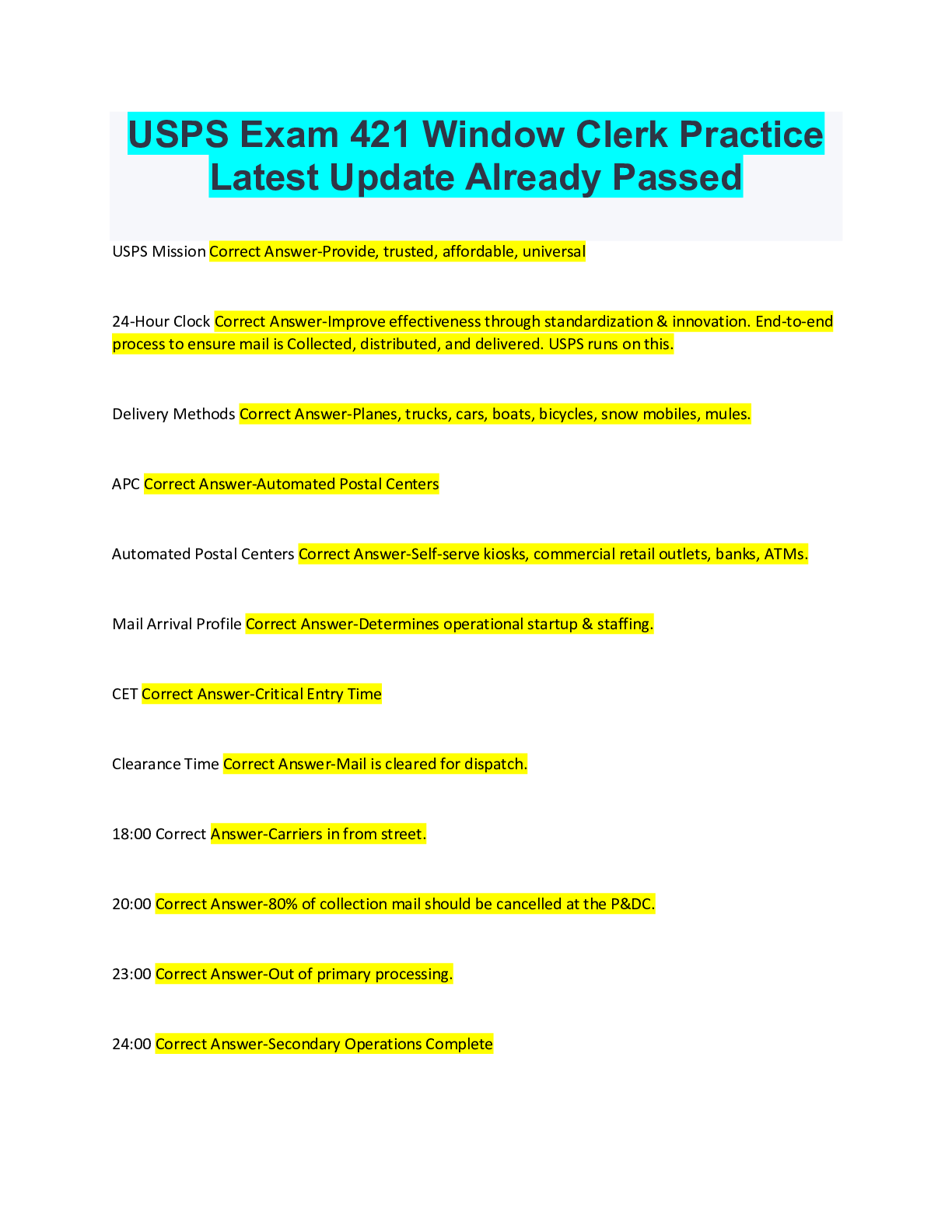


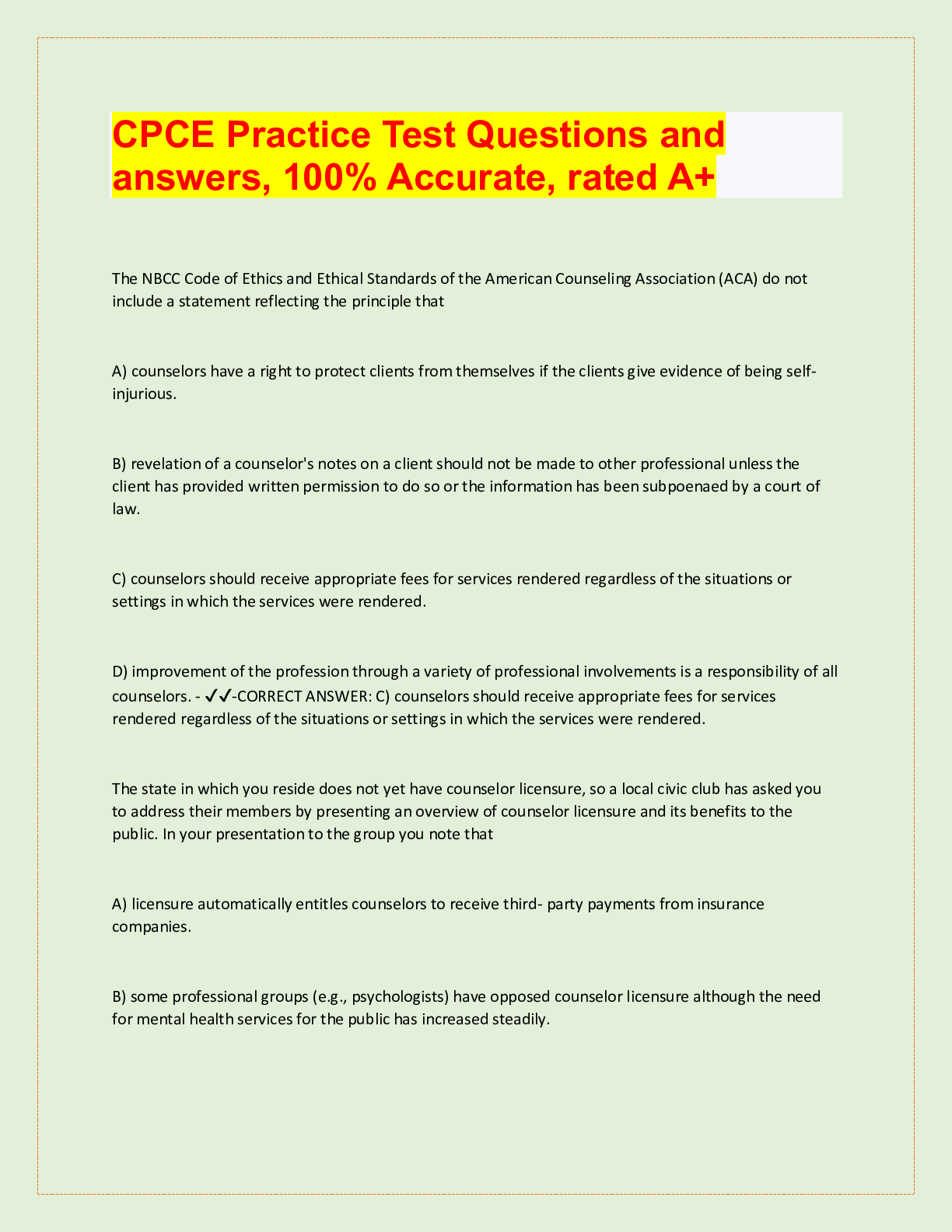

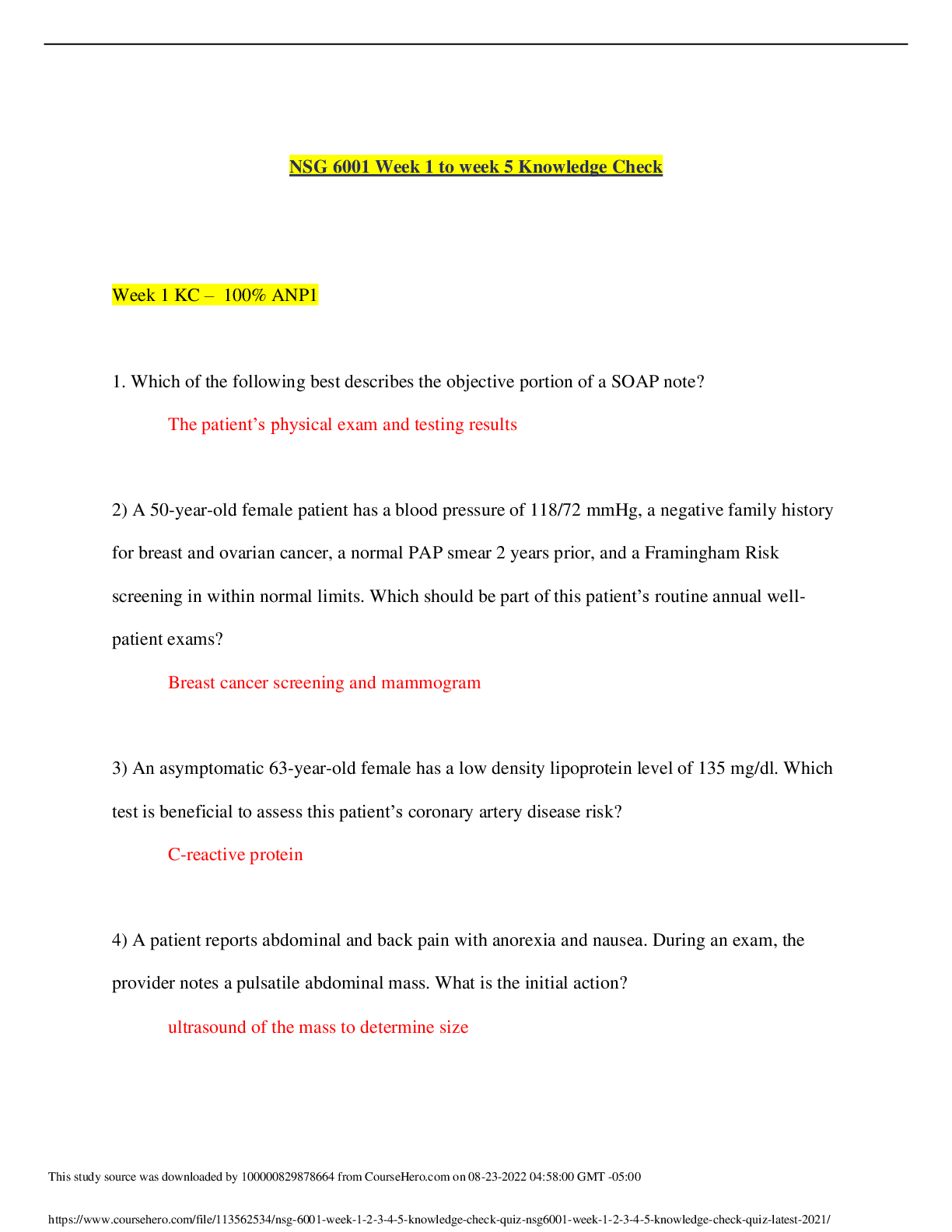
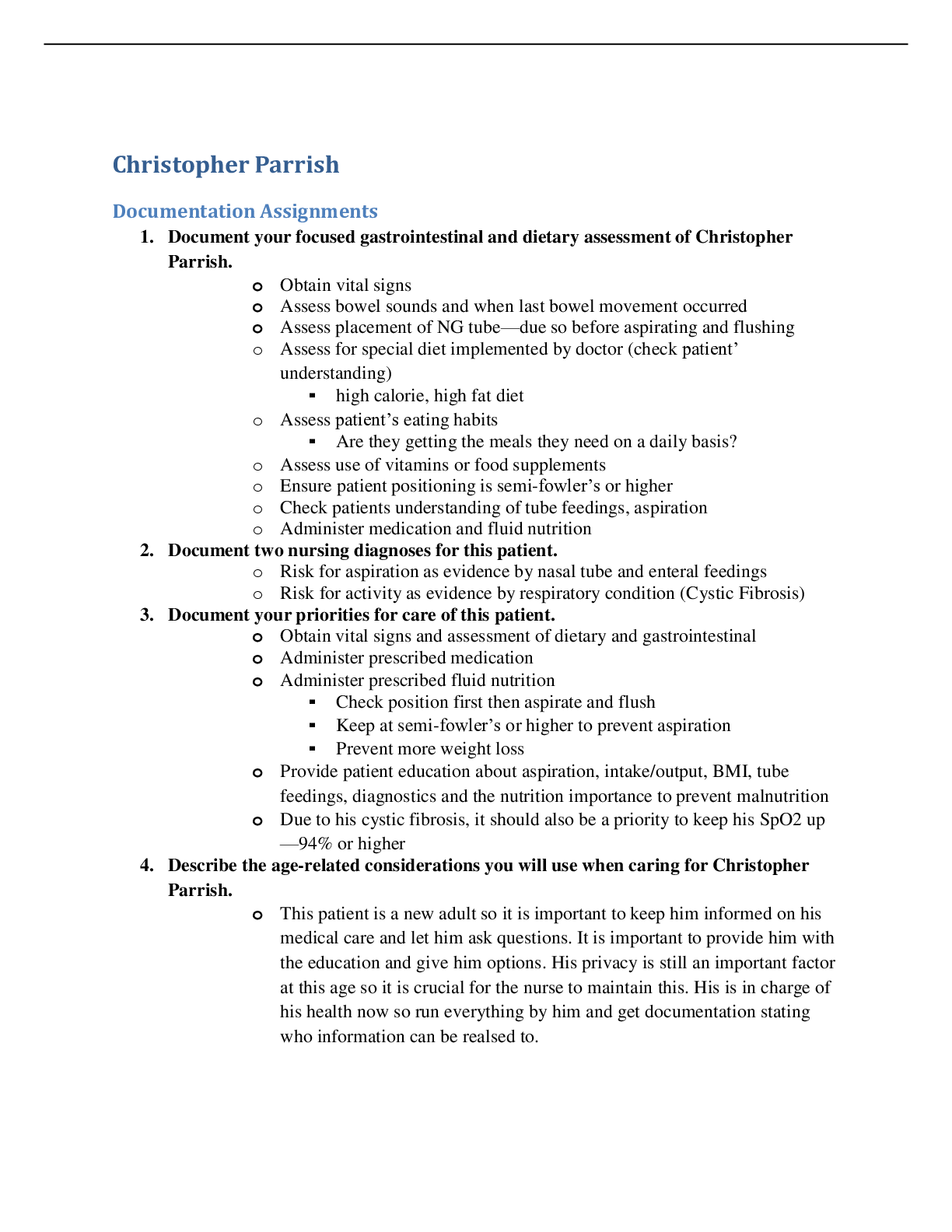
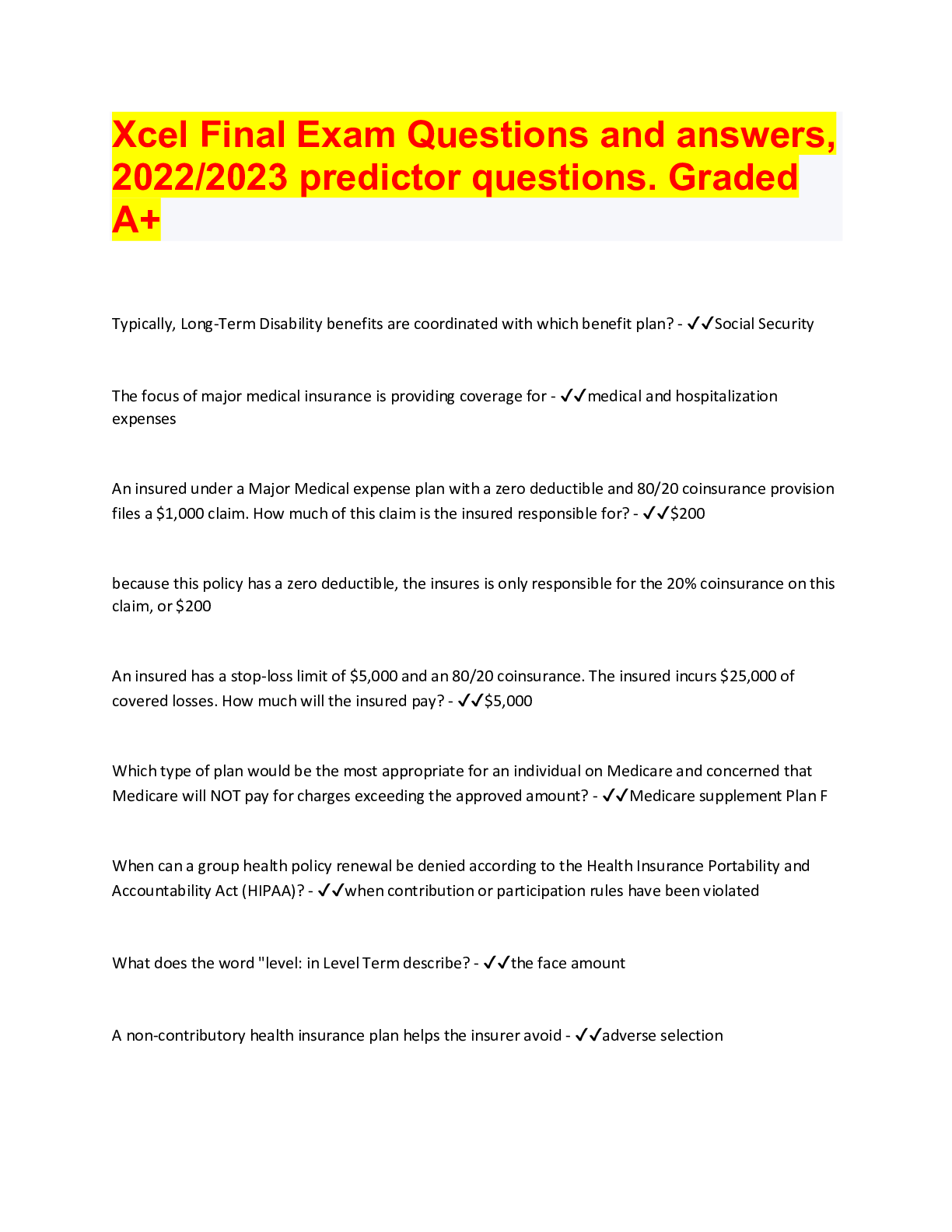

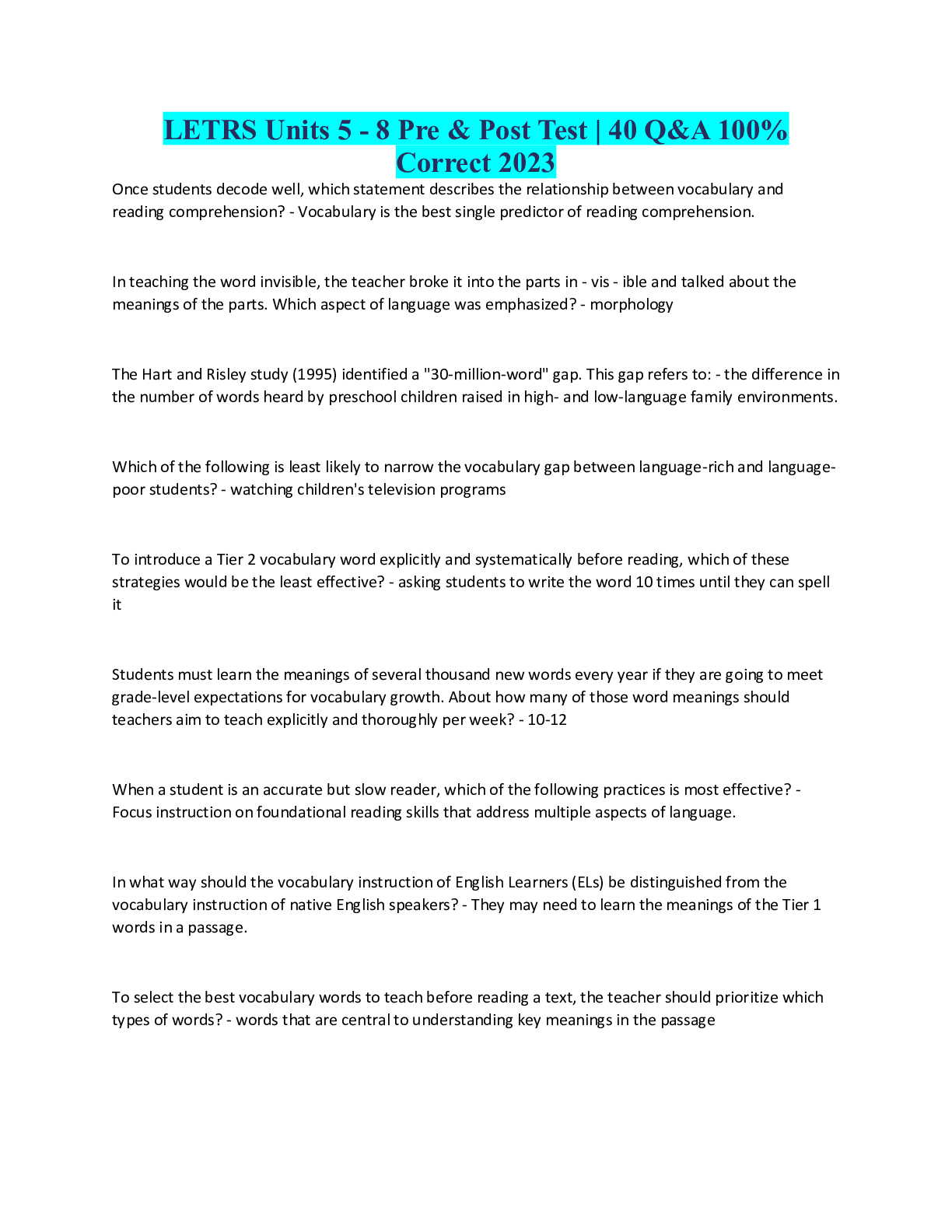
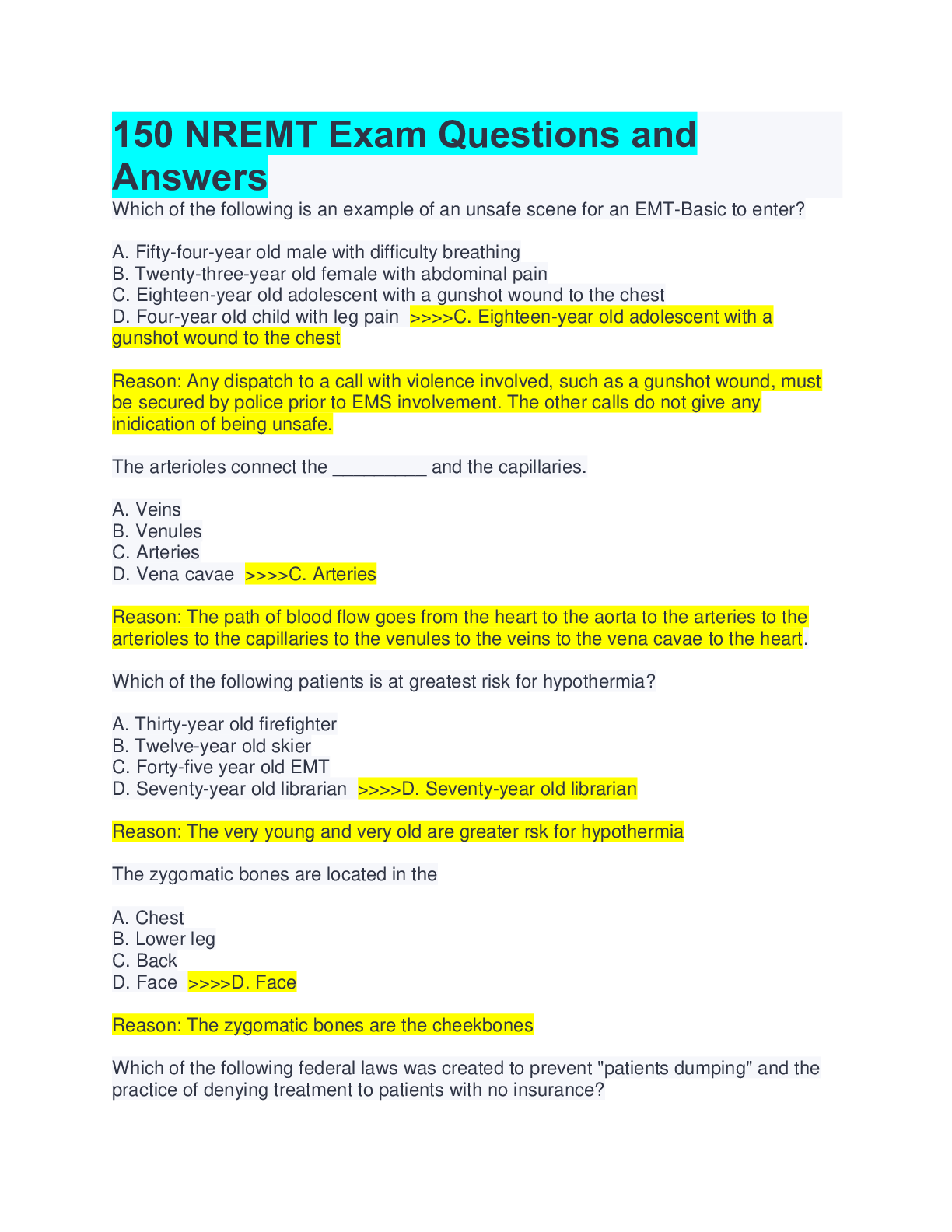


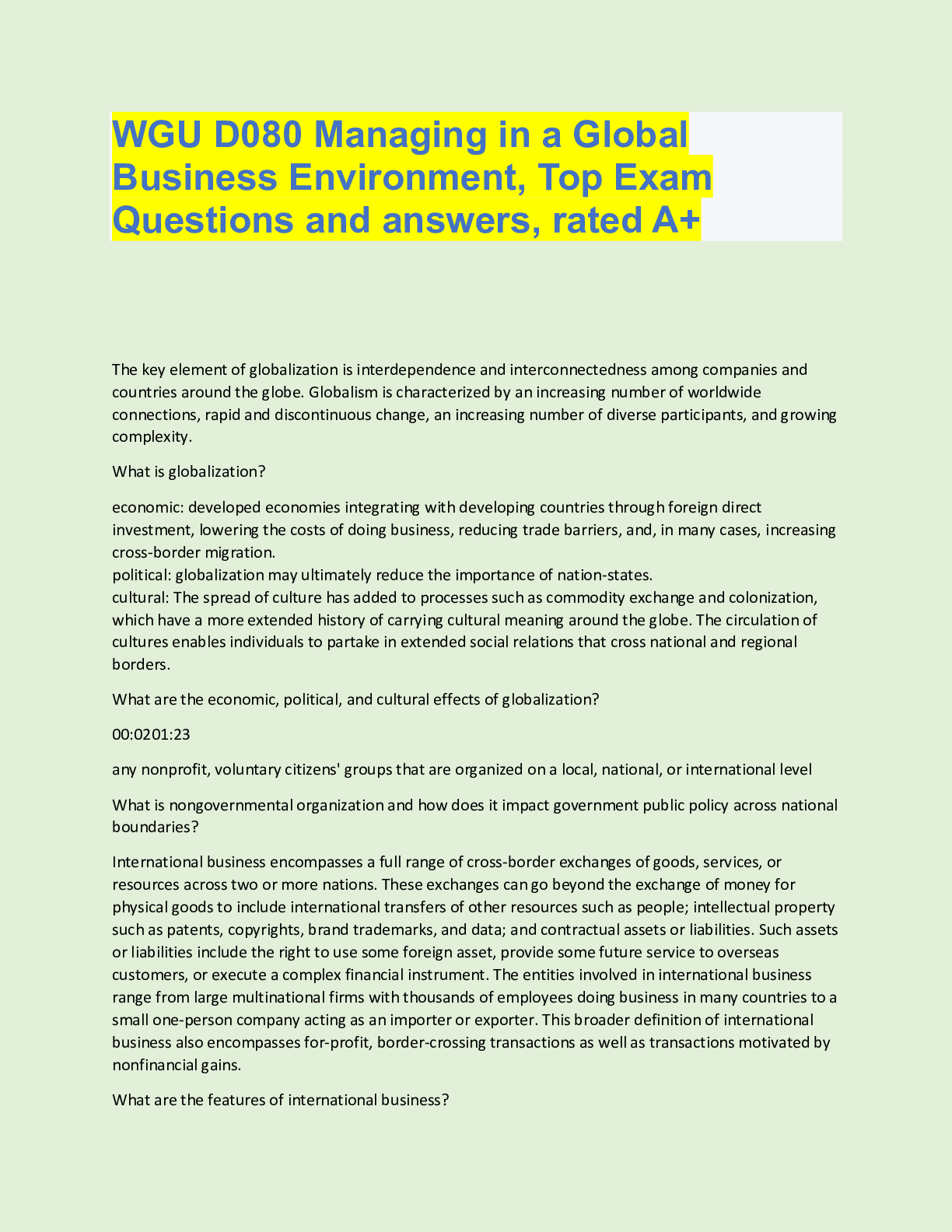
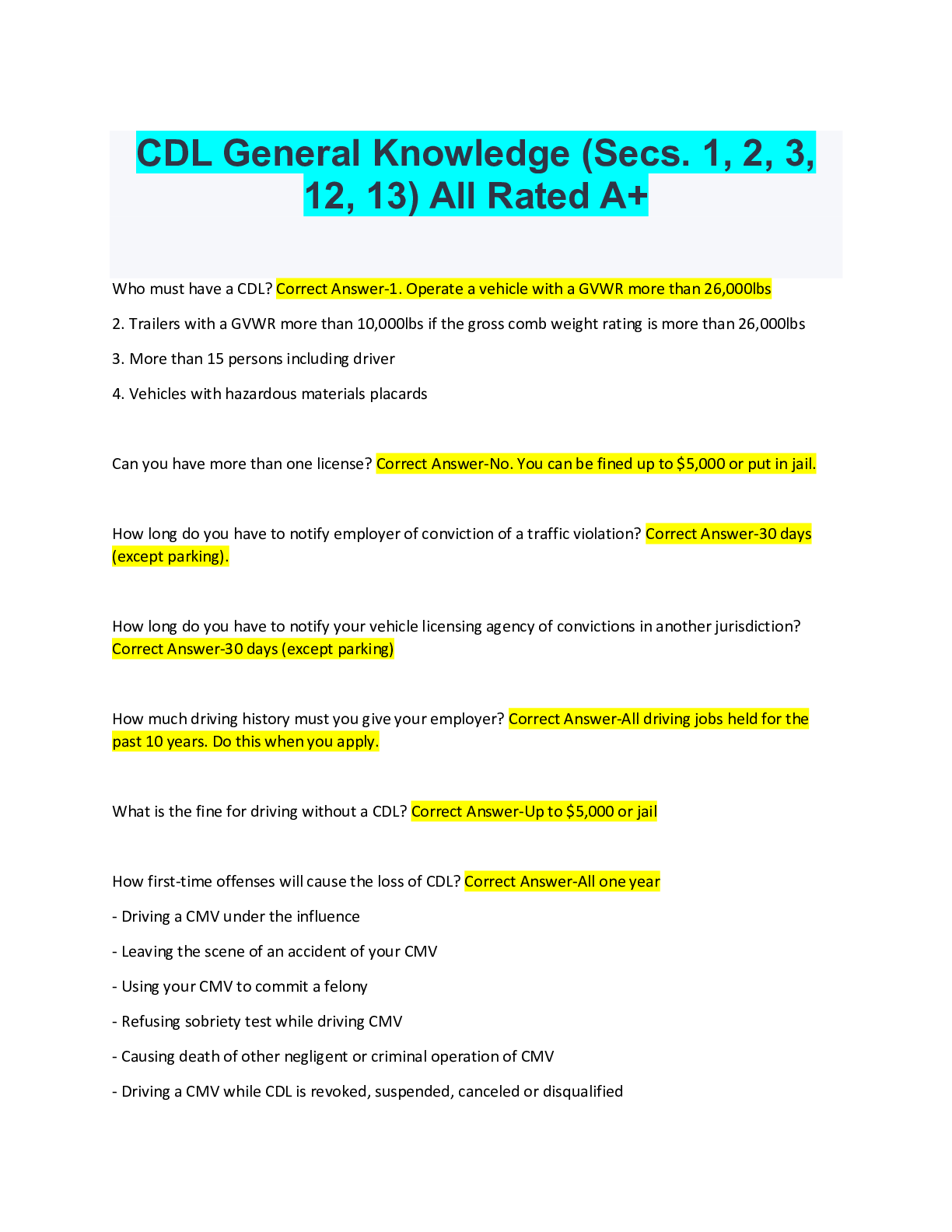
, (A Grade), Questions and Answers, All Correct Study Guide, Download to Score A.png)
, Questions and Answers, All Correct Study Guide, Download to Score A.png)
